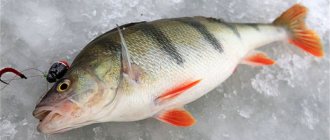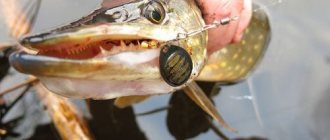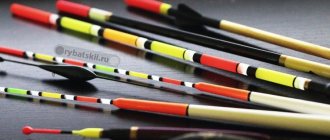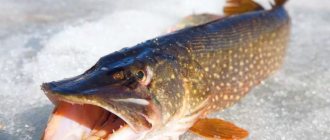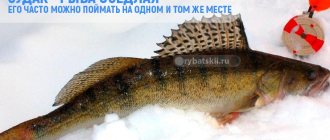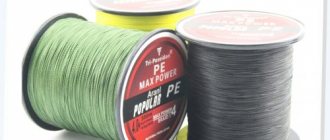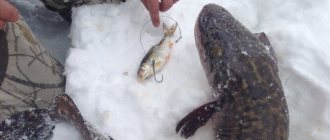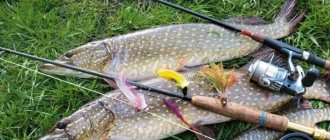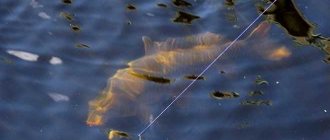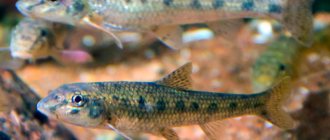What kind of leash should I put on the harness?
The main requirements for the material for the section between the fishing line and the hook are strength and invisibility. Of course, in terms of strength, it is difficult for any material to compare with metals, but pike is an attentive and finicky fish, especially in winter, when the water is exceptionally clear, and the leash should be as inconspicuous as possible.
For these purposes, leashes made from fishing line are used, ranging from conventional ones made of polyamide materials (nylon, nylon) and polyethylene, to Kevlar threads and fluorocarbon.
There were opinions that fluorocarbon is less durable than nylon of the same diameter, but modern high-quality fluorocarbon fishing lines are not inferior in strength to their counterparts.
Which fluorocarbon to choose for pike leashes
Fluorocarbon is one of the most expensive materials in fishing. But its strength has no analogues. Therefore, to catch predators, spinning anglers use fluorocarbon as a leader material.
For pike leashes, the optimal length of fluorocarbon fishing line is a segment of 15-20 cm with a diameter of 0.3-0.5 mm. Such parameters allow the fishing line to remain invisible in the water, while it does not lose strength and can withstand attacks from predators. But if you are hunting for a trophy specimen of pike or perch, then it is better to opt for a longer and thicker leash. Separately, it is worth paying attention to the bottom of the reservoir. If there are sharp stones, it is better to choose fluorocarbon with greater thickness and length.
Tips for fisherman: How to put live bait on a double on a pike - What to choose for fishing
When purchasing, you need to take into account not only the price, but also the manufacturer. It is better to give preference to well-known companies (Trilene), because the likelihood of counterfeiting will be lower. High-quality fluorocarbon is produced by a small number of enterprises. It is also recommended to read the reviews of other fishermen about a particular company.
If any damage is noticed on the fishing line, it must be replaced immediately, because the gathering of fish will be ensured. Such savings will cost more.
Steel wire is somewhat stronger than the previous version. It has proven itself well in relation to bucktail spinners and jerk baits. Since the maximum damage to the equipment from pike teeth can be its bending. You carefully align the wire in a matter of minutes and you can continue fishing. Plus, this is done by hand without any tools or devices.
The best winter leashes and their advantages
The most durable leashes for girders are still those made from metal leash material. Their main disadvantage is their visibility to fish, which is often not compensated for by their strength.
The combination of strength and flexibility is contained in leashes made of tungsten alloys; in addition, they have a fairly high breaking load. But this material is highly susceptible to deformation and after the first bite, the thread from it is curled into a spiral. Of course, the product can be straightened by heating it with a lighter, but then its strength will decrease. In addition, due to the fairly high price, tungsten laces cannot be considered a consumable material.
Fluorocarbon leash for rig
Fluorocarbon leashes have a number of advantages over analogues made from other materials:
No deformation, unlike leads made of metals, especially tungsten;
Invisibility for fish due to the fact that the light refractive index of this material is almost the same as that of water - the coefficient of fluorocarbon is 1.42, that of water is 1.3. This is the greatest advantage of fluorocarbon as a material for fishing line; for comparison, the refractive index of light in nylon is 1.52;
Abrasion resistance. This indicator brings fluorocarbon slightly closer to the strength of metal products. In any case, this material copes better with pike teeth compared to conventional monofilament threads;
Lightness and elasticity, which allows you to counteract line overlaps. Despite its lightness, fluorocarbon sinks 2 times better than nylon, which allows gear made from such material to always be under water;
Resistance to a variety of aggressive environmental influences - temperature fluctuations and extremes, ultraviolet radiation, getting wet.
Advantages
Invisibility in water. From the table at the beginning of the article, you can see that the refractive index of fluorocarbon, the material from which fluorocarbon thread is made, is 1.42, it is very close to the refractive index of water – 1.33. That is why the fishing line is almost invisible in the water, which makes it easier to get bites from cautious fish (carp, crucian carp).
Rigidity. For knitting diverting leashes, it is much better if the fishing line is rigid and does not intertwine with the main cord, but goes to the side, as it should.
Little things: sinks well, is frost-resistant, more difficult to cut on driftwood and shells, does not deteriorate in the sun, practically does not stretch.
Differences between fluorine and monofilament line: fluorocarbon is stiffer and holds knots worse, is less visible in the water, breaks easier and is slightly more expensive per 1 m.
There is also a point of view that fluorocarbon leashes can, on the contrary, cause harm, because because of them, valuable bait has been lost more than once, and the fishermen themselves have been left with nothing.
If you still decide to buy fluorocarbon fishing line, then the best choice would be:
- Owner - for spinning fishing.
- Balzer is a German product that performs well in all fishing conditions and is considered the most versatile choice.
The main advantage of such leashes is their increased rigidity; they do not get tangled or wear out over time, but you should still adhere to a simple rule: the fishing line must remain several times stronger than the leash. Otherwise, you will lose the tackle along with the catch.
Posted by Mityai, 05 August 2008, 14:25:44
Posted by Mityai, 05 August 2008, 14:25:44
0 Users and 1 Guest are viewing this topic.
- Fishermen's forum
- ► For lovers of predatory fish (Fangs)
- ► Spinning
- ► Tackle (Moderator: straznik2010)
- ►Leashes - braided or fluorocarbon?
- Advertising on the portal | Contacts | Help | Terms and rules | Up ▲
- SMF 2.1 Beta 4 © 2021, Simple Machines | Site Map
Recommended age for viewing the site is 18+
The page was created in 0.019 seconds with 20 requests.
There is also a point of view that fluorocarbon leashes can, on the contrary, cause harm, because because of them, valuable bait has been lost more than once, and the fishermen themselves have been left with nothing.
If you still decide to buy fluorocarbon fishing line, then the best choice would be:
- Owner - for spinning fishing.
- Balzer is a German product that performs well in all fishing conditions and is considered the most versatile choice.
Tips for fisherman: How to put live bait on a pike hook - Answers for beginners
The main advantage of such leashes is their increased rigidity; they do not get tangled or wear out over time, but you should still adhere to a simple rule: the fishing line must remain several times stronger than the leash. Otherwise, you will lose the tackle along with the catch.
Differences between fluorine and monofilament line: fluorocarbon is stiffer and holds knots worse, is less visible in the water, breaks easier and is slightly more expensive per 1 m.
Metal leashes, string type, on a girder
Make it even easier. To do this, you can use material purchased in a specialized store or use material available at home, for example, guitar strings or cable wire:
at the end of the wire you need to fold a loop and fix it with several turns around the axis, the same loop needs to be made at the other end of the wire, but twist the tip in the opposite direction, the wire is twisted tightly using a drill and two hooks, one of which is inserted into the tool, and the other screwed somewhere (for example, into a wall).
Universal leash for harness in summer and winter
Is a leash needed on a harness? The answer here is definitely affirmative.
Unlike spinning pike fishing, when the possibility of losing the bait from a cut exists, say, 50 to 50, when fishing with stationary baits, the probability that the bait will end up in the mouth of the predator along with the higher-lying section of the equipment is much greater.
And I am periodically surprised by reviews when anglers use fluorocarbon fishing line or a regular one folded in half as a leader material. At the same time, they claim that they have been catching toothfish this way for a long time and there have been no cuts.
There is neither desire nor point in arguing about this. It is quite likely (and this opinion was formed after watching many videos from YouTube) that mainly grass pikes, which rarely exceed a weight of one and a half kilograms, are caught on the girders. But even if so, does a one and a half pike, say, from the central part of Russia, have fewer teeth than a freckled pike from the lakes of Siberia? Absolutely not.
Pros and cons of tungsten and “pontoon” leashes when fishing with girders
The main criteria for a “good” leash are always reliability and flexibility. If, when fishing with a spinning rod using some models of wobblers, a hard leash is more appropriate than a soft one, then fishing with girders and supplying elastic material reduces the percentage of bites. And the point here is not that, for example, the string gives off glare or the “taste” of metal makes the pike throw live bait (there is such an opinion).
Firstly, I always place the girders in close proximity to steep places. If baitfish gets caught between two, even thin, branches, it too often remains there. A rigid string or wire leash acts as a spacer and does not allow the baitfish to free itself.
Secondly, the rigidity of the steel makes the movements of the mounted fish constrained. When the assortment of leash material was not rich and leashes made by hand were used, from ordinary wire pieces, or chains were woven from nichrome (in the distant school years they made handicrafts all the time), it was already noticed that leashes consisting of links more often brought prey.
The conclusion suggested itself - a live bait mounted on a tee or double has something in its movements that is more attractive to pike than one mounted on a solid piece of steel.
It’s possible that I’m just idealizing, but it is what it is.
Currently, I only use purchased tungsten leashes and homemade leashes made from Ponton 21 leash material. I like the second option better because you can vary the length.
The advantages include:
- Reliability of the material. It is impossible for pike teeth to gnaw through metal.
- Flexibility. Live bait is not at all embarrassed by the presence of a durable piece of equipment that changes shape.
- If we take into account the remark of some garrisons - the predator spits out the bait when it feels metal in its mouth, then I think that in a short period of time it is not realistic to determine whether it has pricked itself on the spines of a perch or on a leash. But even with this conjecture, the flexibility of the tungsten leash will not allow you to sense the presence of a foreign object.
The only disadvantage I can list is the “memory” of tungsten. After a while it becomes like a pig's tail and it is impossible to give it its original shape. In principle, it is not critical.
Something like this. Of course, whether a leash is needed for the girder and what material it should be made of is still the cause of many disputes, you just have to look through the fishing forums. It is likely that the approach has simply changed with the advent of choice and we (anglers) are starting to “dig.” Once upon a time, the ideal was the string - and everyone was happy. But what can be said for sure is that only metal looks on the vent. This is a guarantee of catching a toothy pike and freeing it from suffering when leaving with a hook due to the cut.
Ten schemes for tying a leash to the main line
Triple fisherman
QUESTION: What knot should I use to tie the leash to the main line?
ANSWER: The strength of such a knot is up to 90% of the maximum breaking load of the lines being connected. They are used to connect monofilament lines with a difference in cross-section of up to 0.05 mm.
It is knitted as follows:
Loop to loop - leash to the main line
QUESTION: how to properly tie a leash to the main fishing line?
ANSWER: Loop to loop - such a connection has a strength several times higher than that of most knots.
The knotted ligament “loop to loop” is used in fishing:
- spinning,
- float fishing rod,
- feeder
Used for connecting equipment to the main line, for reliable connection of leads and swivels in various installations.
The procedure for tying a “Loop to Loop” bridle is as follows:
- At the end of the main fishing line, use a figure eight knot to make a simple loop 5-7 cm long.
- On the leader material, performing the manipulations described above, make a small loop of the same length;
- The leash loop is threaded into the loop at the end of the main line;
- The end of the lead line with the hook is threaded through the loop on it;
- The connection is tightened without moistening;
- The ends of the fishing line in the loops are trimmed as much as possible with scissors or a sharp knife.
Tips for fisherman: Fishing with a reelless reel in winter video technique - How to best use
The advantages of such a knot are that, with high strength and reliability, it allows it to be quickly and easily untied. Due to this, it is often used for tying frequently changed feeder leashes of various lengths.
Knot for tying a leash “Blood Ties”
Used to connect monofilament lines with a difference in sections of no more than 30%. More than 85% of the breaking load at the node connection is maintained.
The procedure for knitting such a connection consists of the following manipulations:
Greener for fluorocarbon leader
QUESTION: How do I tie a fluorocarbon leader to the main line?
ANSWER: More reliable than the previous node connection. However, compared to “bloody ties”, it is used to connect monofilaments that differ in thickness by no more than 20%. It is used to connect not only two monofilament lines, but also monofilament and braided cord. Used for tying a fluorocarbon leash to the main line.
The order of knitting such a knot is as follows:
Piotr Minenko knot connection for tying shock leader
Invented by Russian sports fisherman Pyotr Minenko, it is used to connect a monofilament shock leader with a braided cord in feeder, float (match) gear. It is reliable, compact and slips through the guide rings installed on the form without any obstacles.
The procedure for tying such a knot consists of the following steps:
Knot for connecting a monofilament shock leader and a braided cord
Most often used in fly fishing, this knot has high strength and reliability. Compact, passes well through a number of blank pass rings. Consists of a simple knot on a monofilament line and a Clinch knot on a braided cord.
It is knitted as follows:
Albright for fly fishing station
Such a knot is used when connecting lines whose thickness differs by no more than 30%. Widely used in fly fishing (to connect line and leader). It is difficult to knit, but at the same time very durable and reliable. Due to its small size and shape, it does not cling to the inner surface of the rod guides.
The knitting process consists of the following steps:
- A 10-centimeter simple loop is folded from thick wood and fixed with fingers at the base;
- A leader line is passed through the loop;
- Thin fishing line is passed through the loop and 7-8 turns are made around the loop.
- From the remainder of the thin fishing line, a second loop is formed with a tip protruding from it 12-15 cm long.
- Use your fingers to secure the top of the loop from the leader line and the base of the loop from the main line. The tip of the leader line makes several turns around the loop from the main line and the upper part (branch) of the loop from the leader line.
- Having made 10 turns with the tip of the leader line around the loops, it is threaded into the loop from the main line. At the same time, by pulling it up by the end of the fishing line, it is done as little as possible. The resulting knot is moistened and carefully pulled up with the working end of a thin fishing line.
- Tighten the connection by simultaneously tightening the ends of the fishing lines in different directions, while adjusting its turns;
- The ends of the fishing line protruding from the resulting knot are shortened as much as possible.
Particular hope is placed on the leash during the deep winter, when by any means it is necessary to stir up the sleepy fish.
Doubles or tees for girders: how to make a choice
As you know, how many people, so many opinions. This phrase fits perfectly with the topic of this article. Some people prefer to fish with a single hook, others with double hooks, and some exclusively with treble hooks. There is only one thing that opinions agree on - the choice of hook size; most often they use number 10 or 12.
It is recommended to choose the type of hook according to the type of bait and method of baiting. In this article we will look at the features of fishing with doubles and trebles and tell you about the best leashes for pike rigs.
Doubles or tees
Doubles
These hooks are used for long-term fishing. The shank of the hook is passed through the gills of the baitfish, and the stings protrude from its mouth. You can use crucian carp or perch as live bait. Depending on which fish predominates in the pike’s habitat. The positive effect of this method of baiting is excellent camouflage. When swallowing live bait, the predator does not feel the hook, so the chance of an unsuccessful bite or the bait breaking tends to zero.
Another advantage is that this method does not injure live bait and allows you to carefully remove the hook and reuse it on your next fishing trip.
The disadvantage of doubles will be the long wait for a bite ; if the hooking is done ahead of time, most likely the predator will break and you will have to start all over again. Such fishing will definitely not fill you with vivid emotions, but for those who like a quiet, relaxing atmosphere, this will be an excellent choice.
Tees
When fishing with a tee, fishing will be more dynamic. Pike react faster if perch is used as bait. The advantage is that the predator does not react to injections. However, it is important to choose small hooks with a short shank .
Which live bait to choose
The choice of live bait for pike hunting must be approached responsibly. The number of bites and the activity of the predator depends on its choice. It is advisable to choose a type of fish that predominates in the predator’s diet in a particular body of water. It can be crucian carp, roach, silver bream, perch, ruffe, gudgeon or goby. They can be caught right at the fishing spot using a regular winter fishing rod with a jig.
To successfully catch pike in winter, live bait must meet the following requirements:
- Suitable size for local pike. The predator will ignore the bait that is too big, and the small toothy one will peck at the small one.
- The fish attached to the hook must be mobile and not scare off the pike with unnatural behavior.
- The bait on the hook should not fall asleep quickly, so that the angler does not have to frequently reload the equipment.
Photo 4. Roachfish is one of the popular live baits.
Live bait must be stored in spacious plastic or foam containers. Periodically it can be fed with bloodworms or chopped worms. With the right approach, bait can be stored for a month or more without losing its quality.
Take unusual live bait with you – for example, rotans
I would compare fishing with girders in winter to playing chess, because here every step, every action can lead either to victory or to loss and disappointment from the game. And the winter traps themselves are the same chess pieces that you need to move around, constantly thinking through your next actions. As in any game, fishing with girders requires constant learning. And this learning happens on every fishing trip, because every new trip is a new party.
I never cease to be amazed at how seemingly certain nuances often influence its outcome. But I will not dwell on the basics of winter fishing with live bait, but I want to share with readers the subtleties and tricks of winter fishing that I was able to notice and use in my many years of practice.
If you don’t know the reservoir at all, then before placing the vents, first check the area you like using an echo sounder or depth gauge. No echo sounder? Not a problem: make a series of holes and go through them, measuring the distance from the ice to the bottom with the same girder, estimating what depths are below you and how they are located. Any obvious change in the bottom topography, any underwater obstacle, be it a log, a bush or any underwater trash, are potential habitats for fish, including predatory fish.
Having placed the girders, do not be lazy to check them periodically
Take a run near the girders - the sound of your steps sometimes drives the pike out of its underwater shelter
True, this is a very effective step. During fishing, do not forget to run next to the girders several times or walk, tapping the ice with an ice pick. The sound of your steps sometimes drives the pike out of its underwater shelter - and when it sees your bait, it grabs it
But the reel is blocked, and the line does not unwind! But the pike is big, it pulls and doesn’t give up. What then? In my youth I once had such a memorable bite. The pike was pulling strongly, I held the fishing line with one hand, it really cut my palm and fingers, and with the other hand I tried, without much success, to untangle the mess from the fishing line on the reel, which, as I often did then, I threw away from the hole. As a result, the trophy was lost - the fishing line couldn’t stand it.
After that incident, even with the most visually reliable bite, I always try to carefully move the rod away from the hole, making sure that there is an opportunity to give the large pike a walk and get tired on a long leash.
Again, back to the issue of catching large pike in winter using girders. I think it has happened to anglers that you seem to be leading a toothy one, but as soon as you bring it closer to the ice surface, a few sharp jerks - and an empty hook flies out of the hole.
It has been noted that it often happens that a pike, which in principle has moderate resistance when fishing in the water column, begins to thrash and thrash as soon as you bring it under the ice to the hole. She is frightened by the light that comes into the water from the hole. And it is at this moment that she often goes away. To prevent this from happening, the hole should always be darkened. No, you don’t need to do this with snow, because burying yourself in it will give the pike an additional advantage.
The topic of live bait when girder fishing is worthy of a separate discussion, because the outcome of an entire fishing trip often depends on the choice of live bait. You can argue endlessly about what kind of live bait, when and where it is better to use, but for myself I have identified several rules in this matter.
1. If possible, I use as live bait those fish that are found and caught in the body of water where I am placing my girders today. Yes, it’s not always convenient, it’s not always possible, but somehow, historically, my brother and I have been good at catching with “local” live bait.
Take unusual live bait with you – for example, rotans
2. Of course, we often go to a reservoir with a certain supply of live bait, prepared the day before or in advance. And if you have information that the pond where you will be fishing is dominated by, say, roach, then you definitely shouldn’t take only perch with you as live bait. Yes, I agree, there is such a thing that bites do occur with live bait unusual for this place, and maybe even better than when using a familiar local inhabitant, but this is rather an exception. Pleasant, but still an exception.
3. The size of the live bait is a very important point. Typically, fish 8-13 cm long are used as live bait, but if you are aiming for a trophy, then be sure to have larger live bait with you, which you can “place” in deeper parts of the reservoir - in the hope that a large pike will be interested in them. At the same time, I agree, there are also opposite situations: small fish are caught on small fish, while large bait fish are pecked by not very large predators. But in the vast majority, the rule works: the larger the bait, the larger the trophy.
On the body of the caught pike there are traces from an encounter with a larger pike
4. The closer spring is, the smaller the bait should be used. Weighed down by developing eggs and milk, pike prefers small fish, which are a priori easier to catch. This is what experienced baitfish take advantage of, while beginners, using overly large live baits, only wonder why they get so many idle bites.
Tips for fisherman: What is the best way to catch rotan in winter - Let's take it step by step
5. Don't be afraid to experiment with live bait. Yes, we take it according to size and situation in the absolute majority, but it is quite justified to use an extraordinary approach in this matter. For example, if possible, we take with us several unusual live baits - say, molts or gobies. In most cases, pike ignore them, preferring the same roach or perch, but there have been fishing trips when it was unusual live bait that helped us out in the worst biting situations.
6. Keeping live bait vigorous and viable is one of the important tasks of the bait fisherman, because with dead fish the chance of returning home with a catch tends to zero. Therefore, do not be lazy to change their water and remove sleeping fish from the container in a timely manner. Changing the water in a pond is not difficult, but what to do if you have a long journey to get to the fishing spot? Will live bait survive it?
During the winter, the pike does not constantly stand on the same points. And if from late autumn it, say, was caught everywhere, then closer to spring it moves closer to the flowing streams or goes to deeper parts of the reservoir, where it is driven by the lack of oxygen in the water caused by the rotting and decomposition of underwater vegetation. Knowledgeable fishermen take advantage of this by placing their gear in the appropriate areas of the reservoir. Don’t be lazy, especially closer to the last ice period, to sniff the water from the holes.
The more intense the smell of rotting, the less chance that you will catch something in this place: firstly, baitfish will not last long here; secondly, it is far from a fact that the pike will stick to this place and will not prefer an area with fresher water.
When you catch a really large pike, you shouldn’t force things and pull it through. This is exactly the case when a cool head and thoughtful actions are required from the fisherman. For every pull of the fish, you need to be able to force yourself to release the line, while feeling all the movements of the fish.
The equipment of a pike trap includes several elements. In addition to the structural parts of the fishing rod, it consists of the following components:
The best leashes for a female dog
The strongest leashes are made of metal material, but they have a significant drawback: it is very noticeable to the fish. But in winter fishing, when catching pike, this is critical, so strength cannot compensate for it in any way.
Braided steel leashes are also widely used; they are woven from several threads. They are relatively soft and widely available in fishing stores. The disadvantages will also be high visibility for fish, so this is also not the best option. Let's try to figure out which leash for the harness will be better.
A good option would be a tungsten alloy cord; they are quite invisible and can withstand a good load. The disadvantages include the high cost and tendency to deform; after the first bite, the leash will take the shape of a spiral and become more noticeable to the fish.
Fluorocarbon leaders have a number of advantages, which makes them one of the best for pike fishing. Let's take a closer look:
- They do not deform like metal ones, and especially tungsten ones.
- Excellent invisibility for fish, due to the close refractive index of light to water.
- Good abrasion resistance, or rather a low probability that a predator will simply bite it.
- Lightness and elasticity. But despite this, fluorocarbon sinks well.
- High resistance to external factors (ultraviolet, temperature fluctuations, etc.)
The best brands would be:
- Kureha Chemical Industries Co. Ltd;
- Sunline;
- Scientific Anglers.
If financial resources are limited, you can use regular fishing line . You just need to pay special attention to such parameters as:
- Overall strength (biting, tearing, impact);
- Elasticity;
- Abrasion resistance;
- Invisibility for fish.
Important! You can compensate for the insufficient strength of the fishing line by using larger cords from which the braided leash is woven, but this is not a 100% panacea for breaking.
Even with a high breaking load, a predator can bite through it, chewing the fibers one by one. For this reason, the braid must be at least 0.35 mm . In winter, this line can absorb water and freeze to the ice.
The big advantage of monofilament lines is their low cost and low visibility in the water. Also, using such a fishing line, live bait is quite mobile. One of the disadvantages is that it is easy to bite; it is recommended to choose a line thickness of 0.4 mm.
- Fireline from Berkley;
- Power pro manufacturer Shimano;
- Herculine is produced by Sufix.
Note! Information on how to properly tie the leash to the harness is indicated on the box.
Construction of tackle
To begin with, we will describe how the equipment of the girder for winter pike fishing is constructed, without taking into account its design features.
- A sufficient amount of fishing line is wound onto the reel.
- A stopper is put on the end of the working line.
- Next, a sliding sinker is mounted.
- The lower stopper is installed.
- An end loop is made, or a winding ring or carabiner is tied to attach the leash. Some anglers tie the leash directly to the working line.
- The leash is installed.
- A hook is attached.
The reservoirs where pike live have one distinctive feature: a significant part of their bottom surface is occupied by “impenetrable” snags, and in some places this is uprooted fallen forest, and in others it is a forest so flooded that the trunks are not visible at the average level of the reservoir . This “forest” is quite “dense” and well preserved. This alternation of the landscape “pleases” the pike, but creates many additional problems for the angler.
The girder for catching large pikes is not particularly sophisticated and is even, in many respects justified, rather rough (compared to the girder for catching pike-perch). However, when choosing a vent design, it is recommended to adhere to certain rules.
- Choosing a reel for the girder
- Leash for the girder
- Where to look for pike in winter?
- Where to place the girders in winter?
- How does a pike bite?
- How to catch a pike on a girder in an “impenetrable” snag?
- Catching pike on girders in rivers
- Pike menu
Choosing a reel for the girder
Leash for the girder
Each angler makes or buys girders that suit only his taste. If they are manufactured in compliance with these requirements and do not have design flaws, then various nuances of the picture do not change. There should be one requirement: the simpler, more compact - the better.
Where to look for pike in winter?
If the current is strong, then you should always look for a quiet harbor behind a natural or artificial shelter: a protruding cape, a bend in the riverbed, an island, a place where a reverse current forms, etc. Streams flowing into a reservoir are also favorite habitats for pike.
Where to place the girders in winter?
Some of the vents must be placed at depth, the other part - in shallow waters. Only in this case, after a few hours under favorable conditions and a day later under unfavorable conditions, you can confidently say where and at what depth the active pike is staying.
If you fish in places where small individuals mainly live - in the coastal strip or in shallow water that does not go to the hole, then an active search is necessary, associated with the transfer of girders. For example, if the gizzards stood for 1.5 hours in the coastal zone and there were no bites, it is necessary to change the fishing area. In practice, this means moving the vents by 15-30 meters. And so you need to act until the predator’s grip follows. You can drill additional holes in advance, taking into account the possible transfer of the vents.
When fishing for pike, you should remember that placing the girders directly above the hole is useless. It is better when the girders are installed in a place with a difference in depth or on a flat area with average depth and rare snags.
A repeated outbreak of activity can occur only after a few days, and no tricks usually help. If an angler fishes with girders in severe frost, then the hole must be covered with snow or ice chips right up to the reel.
How does a pike bite?
The nature of the pike bite is directly dependent on weather conditions, time of year and oxygen regime of the reservoir. A classic pike bite follows the following scenario.
If the predator is of impressive size and the live bait is small, then its processing occurs very quickly. In this case, the pike usually moves evenly and without pauses before and after the bite. The coil also rotates.
The small pike itself is the object of hunting, and, having grabbed the fry, it hurries to go into shelter, only swallowing it there. Therefore, intensive unwinding of the fishing line at the first stage of the bite does not at all indicate the solidity of the specimen and the quality of the bite that took place.
If the grab occurred near the predator’s parking spot, then you may not be able to wait for an intensive unwinding of the fishing line. You should hook only after the predator has finished processing the live bait, completely swallowing it. This moment is easy to determine by the characteristic twitching of the fishing line - the pike swallows the bait. After this, the coil may make several revolutions, or may begin to unwind intensively.
Under unfavorable weather conditions, in the dead of winter, bites stretch out for an indefinite period of time and do not always have a clearly defined completed phase. A pike can hold live bait in its mouth and not swallow it for quite a long time. Hooking in such a situation does not bring good luck to the angler. In this case, you should try to create in the pike the appearance of prey escaping from its mouth.
To do this, it is necessary to provoke the predator to swallow the live bait with a weak, “microscopic” twitching of the fishing line. It cannot be moved constantly. After each manipulation, it is necessary to wait for a response from the predator.
Tips for fisherman: Do-it-yourself ice drill for winter fishing - What is the difference, pros and cons
If all efforts to whet the pike’s appetite after the bite are in vain, then you need to carefully load the bait again, without lifting the bait, and move some distance away. As a rule, the next actuation of the girder signals more serious pike “intentions”.
How to catch a pike on a girder in an “impenetrable” snag?
The reservoirs where pike live have one distinctive feature: a significant part of their bottom surface is occupied by “impenetrable” snags, and in some places this is uprooted fallen forest, and in others it is a forest so flooded that the trunks are not visible at the average level of the reservoir . This “forest” is quite “dense” and well preserved. This alternation of the landscape “pleases” the pike, but creates many additional problems for the angler.
Therefore, fishing in impenetrable “forest” areas with usually configured girders is just a waste of precious time, injuring not even yourself, but the gullible fish seduced by your bait.
And, nevertheless, in areas of medium, and in some cases, heavy snags, it is quite possible to successfully fish.
When catching predatory fish in a “windfall”, the main criterion for success, after a well-chosen place, is three factors: • the speed of the angler’s reaction to a bite; • length of line on the reel; • flexible leash in a soft shell with a metal core.
The second factor often turns out to be the most important, since the pike takes the bait into the snags sometimes faster than the angler reaches the girder. Classical winding of fishing line onto a reel is carried out on the basis that on average (depending on weather conditions) the pike unwinds from 1 to 6 m of fishing line until the bait is completely swallowed.
The amount of fishing line wound onto the reel depends on the depth of the fishing spot and the specifics of the reservoir. In slightly snagged places with a depth exceeding 3-4 m, the line on the reel should be no more than 12-15 m; at a depth of 1-2 m its length ranges from 5 to 10 m.
Despite the fact that these methods of attaching live bait were described by L.P. Sabaneev more than 100 years ago, they have not lost their relevance to this day. For the fisherman, the main thing is to use them in time and skillfully in practice.
When fishing, when there is no strong current, there is no continuous snag, the “classic” method of attaching live bait under the back is used. The tee is used depending on the size of the live bait, but rarely larger than No. 8-10.
As practice shows, no matter where you fish, there are no completely clean bottom areas. It is always necessary to be close to the females, closely watching them. If an angler deliberately fishes in snags with baits that are not adapted for this purpose, then only the noticed bites end in success. If the angler “missed” the moment of the bite, he has only 15 percent chance of pulling out the desired trophy, no more.
The use of a metal leash for catching pikes in many bodies of water is a controversial issue, but when fishing in snags you can’t do without a leash, since the predator, despite all its tricks, still has to be pulled out of impenetrable rubble, and the pressure of the pike teeth on the fishing line in this case increases 3-4 times.
Catching pike on girders in rivers
Therefore, the tactics for catching pike in winter on flowing rivers differs from catching pike in stagnant bodies of water, where algae become a serious nuisance for fish 1-3 weeks after the formation of ice, because they absorb oxygen and poison all living things.
With the onset of spring and the approaching spawning season, pike move towards small spawning bays bordering open water. By this time, not only catching predatory fish, but also moving on ice becomes life-threatening. Therefore, it is necessary to finish fishing in early March, and with the onset of early spring, even in mid-February.
Pike menu
For the reservoirs of central Russia, it is only possible to compile a pike menu approximately. It will look something like this: • roach; • gudgeon; • crucian carp, bream, roach; • perch; • dace; • bleak; • ruff.
The dignity of live bait is determined by its ability to “play”, attracting the attention of predators. If the baitfish hangs on the hook without moving, the “toothy” bites occur much less frequently and are random in nature. Live bait used when fishing with girders weighs on average 15-30 g. Depending on the size of the live bait and the diameter of the leash, tees or doubles Nos. 6-8 and single hooks No. 8-12 (according to domestic numbering) are used.
If live bait is delivered to a reservoir in eland, the main condition for its life activity is the gradual replacement of “home” water with water from the reservoir. For live bait, sudden changes in water temperature and its composition are unacceptable. Change no more than 1/4 of the volume at a time.
Types of winter girders
Selection of leashes for equipping girders
When catching a toothy predator, there are no trifles; every element of the gear must be selected with skill. This also applies to the leader material, which in the case of this fish should not only be invisible, but also durable, since bitten or frayed gear with incorrectly selected materials is not uncommon, especially when biting a large specimen. Leashes for catching pike on girders must also be selected taking into account the likelihood of friction on the ice at the final stages of fishing, because losing a catch at this moment, when the catch is almost in your hand, is especially offensive.
How to catch pike in winter using girders
Catching pike with girders in winter, with girders placed on the pond
In order to ensure a good catch, you first need to choose the right place for fishing. Ideally, it would be to discover the habitat of the pike. Having found a fish outlet, in one day you can catch up to 5-7 individuals of these predators and, perhaps, a large pike will be among them. This is normal for a nerd. If desired, you can also fish at night.
Where to place the girders?
In winter, pike are mainly found in the pond in ambush. From the same place she constantly watches the fish swimming nearby. As soon as the prey approaches the required distance, the predator suddenly attacks it.
It is necessary to make winter supplies and install girders in certain places depending on the type of reservoir:
- On the rivers . In this case, it is better to choose deep bays, holes under rifts, small pools, or plants above capes.
- On ponds and lakes . In such a situation, you need to navigate along the boundaries of vegetation. You can also choose places in the channels between the island and the shore. You need to pay attention to snags, cliffs and bushes.
To examine the bottom of a reservoir, it is best to use an echo sounder. If the reservoir will be visited for fishing in the future, you can use a jig or a spinner instead. In the process of examining the bottom, it is important to note for yourself various changes in depth or the presence of any obstacles. It would not be superfluous to analyze the behavior of local fishermen, since they must know exactly all the features of a particular reservoir.
How to properly place girders on pike in winter?
Good, interesting and effective fishing can be ensured by correctly stopping the girder. To do this, you need to adhere to the following tips:
- it is worth choosing steep banks;
- the current at the site where the hole is created should be slow and calm;
- the distance to the shore should not exceed 20 meters.
The distances between the girders should be such that the fisherman can move without any difficulties, in time for a bite. The bait installation technique should take place directly on the reservoir - after holes have been drilled in the ice.
When does pike bite on girders in winter?
In order for fishing to be as successful as possible, it is very important to understand when exactly in the winter the pike bites on the girders. In this regard, there are the following behavioral features of this predatory fish that need to be taken into account:
Tips for fisherman: How to properly fish with a reelless reel in winter - Choosing the best
Thus, by fishing in accordance with the above tips, you can secure a significant winter catch of pike.
No matter how correctly the girder is equipped and configured, if it is installed in a fishless place, you may not get a bite at all, not to mention any catch. You need to go fishing for pike in winter, understanding its habits, parking zones and knowing the characteristics of a particular body of water. An important role is played by the experience of the fisherman and the ability to fish in this way.
Metal options
A leash for a pike harness made of metal is most common. This option is the only guarantee that the equipment will not be bitten, since fluorocarbon, braid, and monofilament can easily not withstand a meeting with the teeth of a predator.
Most often, you can find stainless steel options on sale - such leashes have greater tensile strength, which allows them to be made with a small diameter, thus reducing visibility in the water. Such a product does not change its shape during use, and is not damaged either by the edge of the ice or by stones or shells at the bottom. The only significant drawback is visibility in water, especially clear water, which can scare off a not too active and cautious predator.
Fluorocarbon leaders
Winter is that time of year when the water in any body of water is characterized by maximum transparency, which means that the gear should be as inconspicuous as possible. Of the modern materials used in fishing, fluorocarbon best meets this requirement. A fishing line made from it has the following advantages for winter and summer use:
- This material has a refractive index of light that is closest to that of water. This means fluorocarbon is maximally transparent and invisible to fish even with large diameters.
- Resistance to abrasive influences. Fluorocarbon is very popular among spinners who fish on shell or rocky bottoms; it is also used in feeder fishing in similar conditions.
- But one more property - low stretchability, when used as a leash can be considered rather a disadvantage. Because of this, fluorocarbon practically does not absorb the jerks of large fish, which potentially threatens the breakage of the gear.
- Unlike conventional fishing line, the shape memory effect is practically absent; after storage on the reel, the fluorocarbon leader remains smooth and does not curl into a spring.
Important! When choosing fluorocarbon, you should trust trusted manufacturers. Too cheap Chinese products rarely correspond to the characteristics stated on the packaging.
Regular monofilament
It is possible to catch a pike with such a tackle, but it should be taken into account that its teeth can bite through, depending on the size of the fish, monofilament with a diameter of 0.4 mm or more. Such leashes are also used, but more often it is forced when it is not possible to use a better option.
Monoline is not highly durable or resistant to abrasives, loses strength when exposed to ultraviolet radiation and can be bitten by pike. Such leashes are used mainly due to the low cost of the material, as well as the ease of manufacture in camping conditions, when it is simply not possible to tinker with crimp tubes and other more reliable ways to secure the loops at the ends of the leash.
Network
Braided fishing lines are used as leashes in winter and summer fishing, although relatively infrequently. The main problem with braided line is its high visibility, as well as not the best resistance to abrasive influences, which increases the likelihood that such a leash may simply rub against the edge of the ice during fishing.
Another problem with braided line is that most of these lines are painted in bright colors, since the manufacturer does not suggest this option for their use, and high visibility makes it easier to cast, detect bites and maneuver feeder or spinning tackle. However, these shortcomings are compensated by the ability to quickly tie several leashes on the go, without using any additional tools, which is necessary in situations where purchased options have run out.
The nuances of tying a leash to a spinning rod
To connect leashes to a spinning fishing line, it is better to use monofilament fishing line. If you plan to go fishing for a large pike, you should change the fishing line to titanium thread and use a special three-hook spinner.
For monofilament fishing line, a simple tangle-free “Gringer” knot is suitable:
- We pass the free end of the fishing line into the eye of the spinner or bait.
- We form a loop, throw the working end of the fishing line over the main fishing line.
- We pass the working end into the formed loop and begin winding the doubled fishing line.
- You need to make five or seven turns, then moisten the knot and tighten it.
- the knot is tightened until a figure eight is formed. This is determined visually;
Many reliable knots are described and shown on how to tie a leash to the main line, but most of them are not suitable for tying additional leashes with hooks.
The proposed method of tying additional side leashes is characterized by ease of execution, reliability and 100% solves the problem of how to tie a second leash to the main fishing line.
When starting to equip a float rod, elastic tackle, etc., it is necessary to determine in advance the number and length of leashes, and also pre-mark the places where they are attached. For convenience, you need to leave a sufficient supply of fishing line, taking into account its shortening due to the formation of knots. The order of tying the leashes is done in the direction from the rod to the place where the sinker is attached.
Tips for a fisherman: Farewell to winter 2021, what date - Tips for a beginner
This method is good because it is excellent for connecting fishing lines of different diameters, and this is important when tying leashes, which are usually 10% thinner than the diameter of the main fishing line .
Sequence of tying additional side leashes:
— in the selected place where the leash is attached, a loop is formed on the main fishing line, into which the free end of the fishing line is inserted three times on one side (as when tying a triple knot);
- the knot is tightened until a figure eight is formed. This is determined visually;
- the end of the leash is passed through both loops of the formed figure eight;
— the leash is tied with any usual knot. The clinch knot is perfect for this purpose - it is a reliable and easy-to-use knot;
— all that remains is to perform a thorough tightening of the figure eight.
The knots are wetted before final tightening.
Using this method, you can easily attach the required number of additional side leashes. Tying the second leash is shown in the video below.
Next, pass the free end into a half-loop
